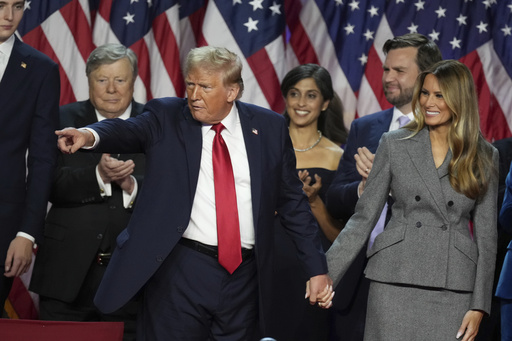
WASHINGTON — As Donald Trump prepares for his anticipated return to the White House, he aims to establish an entirely new administration distinct from the one led by President Joe Biden. His team is asserting that this second administration will also differ significantly from the first that Trump set up after winning the election in 2016.
The president-elect has a transition period of 75 days leading up to Inauguration Day on January 20, which he will use to assemble his team. A key responsibility will involve appointing approximately 4,000 individuals to various government roles, specifically those selected by Trump’s team as political appointees.
These appointments include crucial positions such as the secretary of state and heads of Cabinet-level departments, as well as individuals chosen for part-time roles on boards and commissions. Out of these presidential appointments, about 1,200 require Senate confirmation, which may be more manageable now that the Senate has shifted to Republican control.
So, what can we expect from this transition? Although Trump will be overseeing a completely new administration, he is well aware of the steps he needs to take. Having previously built a new administration for his first term, he has clear ideas about how to take a different approach this time around.
Trump has already mentioned several potential appointees. During his victory celebration early Wednesday, he indicated that he would enlist Robert Kennedy Jr., a former presidential candidate and advocate against vaccinations, to “help make America healthy again,” stating that they would allow him to proceed with initiatives in this area. Additionally, Trump reiterated his commitment to appoint Elon Musk, born in South Africa and a prominent supporter of Trump’s campaign, to the position of secretary of federal “cost-cutting.” Musk has previously indicated he could identify trillions in potential government savings.
Beyond filling these essential roles, the transition period also allows presidents-elect to receive regular intelligence briefings. For example, in 2008, George W. Bush provided Barack Obama with insights on U.S. covert activities. Similarly, during Trump’s 2016 transition, Obama’s national security adviser, Susan Rice, briefed Michael Flynn, who was set to assume a critical role in the new administration. However, Trump’s legal disputes over the 2020 election results delayed Biden’s transition process, which only began to unfold on November 30.
Who is assisting Trump in this process? The transition team is primarily composed of friends and family members, including Kennedy Jr., former Democratic presidential candidate Tulsi Gabbard, and Trump’s adult sons, Donald Jr. and Eric Trump, alongside his running mate, JD Vance. Co-chairing the transition are Howard Lutnick, CEO of Cantor Fitzgerald, and Linda McMahon, a former wrestling executive who previously served as administrator of the Small Business Administration durante Trump’s first presidency.
Lutnick stated that this operation is fundamentally different from the one executed in 2016, which was initially led by Chris Christie. Following his victory eight years ago, Trump removed Christie from his role and pivoted the transition to Mike Pence.
In forming his Cabinet during his first term, Trump selected a mix of mainstream Republicans and business leaders, but many later expressed disappointment or distanced themselves from him. This time, Trump has emphasized the importance of loyalty, suggesting that his selections will align closely with his political inclinations and flamboyant style.
Unlike the campaign team led by Democratic Vice President Kamala Harris, Trump’s crew did not establish any pre-Election Day transition agreements with the General Services Administration (GSA), which facilitates federal operations. This oversight already places Trump at a disadvantage, as he missed essential deadlines for logistical arrangements like office space and technological support, along with access to vital documents and personnel.
New protocols have been implemented since the complications experienced during the last transition period. In 2020, Trump claimed that non-existent voter fraud affected his election outcome, which postponed cooperation between his administration and Biden’s team. The head of the GSA, Emily Murphy, had declared a lack of legal capacity to declare a winner while Trump contested the election results in court, delaying transition funding and resources.
It wasn’t until Trump’s attempts to dispute election results faltered in crucial states that Murphy finally agreed to acknowledge a president-elect and initiate the transition. Eventually, Trump publicly stated his administration’s commitment to cooperate.
To ensure smoother transitions going forward, the Presidential Transition Improvement Act of 2022 mandates that transition activities commence five days post-election, even if the victor remains under dispute. This rule aims to prevent delays and states that an “affirmative ascertainment” by the GSA is no longer required to access transition support services.
The aftermath of the 2000 election provides context for the importance of these new regulations. Following a five-week delay due to a Supreme Court decision regarding a contentious election between George W. Bush and Al Gore, Bush was left with reduced time to manage the administration transfer from Bill Clinton’s team. This situation raised concerns about potential national security vulnerabilities and contributed to U.S. unpreparedness during the September 11 attacks a year later.
